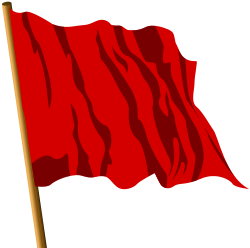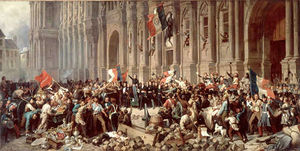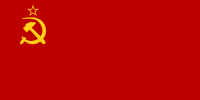Red flag

In politics, a red flag is a symbol of left-wing politics, in particular, of Communism. It has been associated with left-wing politics since the French Revolution.[1] Socialists adopted the symbol during the Revolutions of 1848 and it became a symbol of communism as a result of its use by the Paris Commune of 1871.[2] The flags of several communist states, including China, Vietnam, and the Soviet Union, have red backgrounds. The Labour Party in Britain used it until the late 1980s, and the French Socialist Party uses it, as well as the Social Democratic Party Of Germany (SPD).
Contents |
History

In the Middle Ages, ships in combat flew a long red streamer, called the Baucans, to signify a fight to the death.[3] In one petition, a group of English sailors asserted that the Crown had no right to a share of the prize money earned from a Norman ship captured in 1293 because it had raised the Baucans.[4] (Raising this streamer may have been a relatively novel practice at this time, since the writers feel the need to explain it.) By the 17th century, the Baucans had evolved into a red flag, or "flag of defiance."[5] It was raised in cities and castles under siege to indicate that they would not surrender.[6] "The red flag is a signal of defiance and battle," according to Chambers Cyclopedia (1727–41).[7]
The red cap was a symbol of popular revolt in France going back to the Jacquerie of 1358. The color red become associated with patriotism early in the French Revolution due to the popularity of the Tricolour cockade, introduced in July 1789, and the Phrygian cap, introduced in May 1790. A red flag was raised over the Champ-de-Mars in Paris on July 17, 1791 by Lafayette, commander of the National Guard, as a symbol of martial law, warning rioters to disperse.[8] As many as fifty anti-royalist protesters were killed in the fighting that followed. Oddly inverting the original symbolism, the Jacobins protested this action by flying a red flag to honor the "martyrs' blood" of those who had been killed.[9] The Jacobin Club ruled France during the Reign of Terror (1793-1794) and made the red flag an unofficial national emblem.[1] However, the earlier Tricolor never lost its official status and regained popularity under Napoleon.
British sailors mutinied near the mouth of the River Thames in 1797 and hoisted a red flag on several ships. Two red flags flown by marchers during the Merthyr riots of 1831 in South Wales were soaked in calf's blood.[10] The red flags of Merthyr became a potent relic following the execution of early trade unionist Dic Penderyn (Richard Lewis) in August 1831 despite a public campaign to pardon him.

At much the same time, the Liberal "Colorados" in the Uruguayan Civil War used red flags. This prolonged struggle at the time got considerable attention and symapthy from Liberals and revolutionaries in Europe, and it was in this war that Garibaldi first made a name for himself and that he was inspired to have his troops wear the famous Red Shirts.
During the 1848 Revolution, Socialists and radical republicans demanded that the red flag be adopted as France's national flag. Led by poet-politician Alphonse de Lamartine, the government rejected the mob's demand: "[T]he red flag that you have brought back here has done nothing but being trailed around the Champ-de-Mars in the people's blood in [17]91 and [17]93, whereas the Tricolore flag went round the world along with the name, the glory and the liberty of the homeland!"[11]

The banner of the Paris Commune of 1871 was red and it was at this time that the red flag became a symbol of communism.[2] The flag was flown at a May Day rally for an eight-hour workday in Chicago in 1886. A bomb blast killed a policeman and the Haymarket Eight were arrested and five were executed. This event, considered the beginning of the international labor movement, is still commemorated annually in many countries (although not in the U.S.) The red flag gained great popularity during the Russian Revolution of 1917.[12] The Soviet flag, with a hammer, a sickle and a star on a red background, was adopted in 1923.[12] Various Communist and socialist newspapers have used the name The Red Flag. In China, both the Nationalist Party-led Republic of China and the Communist Party-led People's Republic of China use a red field for their flags, a reference to their revolutionary origins.
In more recent times, social democratic parties have gravitated away from the Red Flag as a symbol. However, several European parties retain a "red square" symbol, including Germany's SPD and the Party of European Socialists.
The British Labour Party
The red flag was the emblem of the British Labour Party from its inception until the Labour Party Conference of 1986 when it was replaced by a red rose, itself a variant of the "Fist and Rose" then in wide use by left of center parties in Europe. The more floral red rose design has subsequently been adopted by a number of other socialist and social-democratic parties throughout Europe. Members of the party also sing the traditional anthem The Red Flag (see below) at the conclusion of the annual party conference. In February 2006 the Red Flag was sung in Parliament to mark the centenary of the Labour Party's founding.
Laws to ban red flags
During the Red Scare of 1919-20 in the United States, many states passed laws forbidding the display of red flags, including Minnesota, South Dakota, and Oklahoma.[13] Most of these statutes have been repealed, but an Oklahoma statute still provides that flying "any red flag or other emblem or banner, indicating disloyalty to the Government of the United States or a belief in anarchy or other political doctrines or beliefs, whose objects are either the disruption or destruction of organized government, or the defiance of the laws of the United States or of the State of Oklahoma" is a felony punishable with a 10-year prison sentence and a $1,000 fine.[14] The current flag of Oklahoma dates to this period, and was adopted due to the association of the first flag of Oklahoma, a white star on a red background, with socialism. The statute is unlikely to pass constitutional muster (see Brandenburg v. Ohio (1969)), but has not been challenged.
The song "The Red Flag"
The song "The Red Flag" was written by Irishman Jim Connell in 1889. It is normally sung to the tune of "Lauriger Horatius", better known as the German carol "O Tannenbaum", though Connell had wanted it sung to the tune of a pro-Jacobite Robert Burns anthem, "The White Cockade". The lyrics of the first verse and the chorus, which are the most well-known parts of the song, are as follows:
- The people's flag is deepest red,
- It shrouded oft our martyr'd dead
- And ere their limbs grew stiff and cold,
- Their hearts' blood dyed its ev'ry fold.
- Then raise the scarlet standard high,
- Within its shade we'll live and die,
- Though cowards flinch and traitors sneer,
- We'll keep the red flag flying here.[15]
There are a number of satirical versions of the song, such as "The People's Flag Is Palest Pink". A version of the song with similar lyrics entitled "We'll Never Die" is the official anthem of Manchester United F.C. The melody is used in Harold Baum's "The Michaelis Anthem" in The Biochemists' Songbook.[16] The British Labour Party uses the song as its anthem and closes its annual party conference with the song, although during the Tony Blair years the leadership sought to downplay its role.[17][18]
Complete Lyrics
- The people's flag is deepest red,
- It shrouded oft our martyred dead,
- And ere their limbs grew stiff and cold,
- Their hearts' blood dyed its every fold.
- Then raise the scarlet standard high. (chorus)
- Within its shade we live and die,
- Though cowards flinch and traitors sneer,
- We'll keep the red flag flying here.
- Look round, the Frenchman loves its blaze,
- The sturdy German chants its praise,
- In Moscow's vaults its hymns were sung
- Chicago swells the surging throng.
- It waved above our infant might,
- When all ahead seemed dark as night;
- It witnessed many a deed and vow,
- We must not change its colour now.
- It well recalls the triumphs past,
- It gives the hope of peace at last;
- The banner bright, the symbol plain,
- Of human right and human gain.
- It suits today the weak and base,
- Whose minds are fixed on pelf and place
- To cringe before the rich man's frown,
- And haul the sacred emblem down.
- With head uncovered swear we all
- To bear it onward till we fall;
- Come dungeons dark or gallows grim,
- This song shall be our parting hymn. [19]
Communist/socialist Red Flag as name or title
It has been common to find streets, buildings, businesses and product brands named after the Red Flag in socialist countries. For example, a famous line of limousine cars manufactured by China FAW Group Corporation has the brand name of Red Flag.
See also
- Red star
- Hammer and sickle
- Black flag
- Flag of the Soviet Union
- Flag of the People's Republic of China
- Flag of Vietnam
- Red bloc
- Communist symbolism
- Eureka Flag
- Red flags in the Gallery of confusable flags
References
- ↑ 1.0 1.1 Brink, Jan ten Robespierre and the Red Terror, 1899.
- ↑ 2.0 2.1 "Story of the Red Flag", Revolution, 05-19-2006. Retrieved 12-02-2007.
- ↑ Flags of the World, "Baucans (or Bauccedillian)".
- ↑ Marsden, R.G., "Early Prize Jurisdiction and Prize Law in England" (1909)
Perrin, W.G. British Flags: Their Early History, and Their Development at Sea; with an Account of the Origin of the Flag as a National Device (1922) p, 161. - ↑ 1602 Dekker Satirom. Wks. 1873 I. 233 What, dost summon a parlie, my little Drumsticke? tis too late: thou seest my red flag is hung out.
1666 Lond. Gaz. No. 91/4 That the Red Flag was out, both Fleets in sight of each other, expecting every hour fit weather to Engage.
Flags of the World, "Flag of Defiance." - ↑ "so the red flag of defiance was pulled down", Grant, James, Cassell's Old and New Edinburgh, Vol. 1, (1882) p. 49.
- ↑ Cited in "red flag," Oxford English Dictionary.
- ↑ Thomas Carlyle, French Revolution, p. 408.
- ↑ Flags of the World, "French Revolution"
- ↑ Saunders, Bob, "The Merthyr Rising 1831"
- ↑ Flags of the World, "France"
- ↑ 12.0 12.1 Flags of the World, "Soviet"
- ↑ Zechariah Chafee, Jr., Freedom of Speech (NY: Harcourt, Brace and Howe, 1920), 180ff., Appendix V
- ↑ Oklahoma Statute 21 O.S. §374, O.S. 5 § 9 (374), Statutes Citationized, Oklahoma State Courts Network.
- ↑ http://webpages.dcu.ie/~sheehanh/rf-lyrics.htm
- ↑ http://www.csulb.edu/~cohlberg/songbook.html mp3
- ↑ The Red Flag ends Labor rally, BBC, 1 October 1999
- ↑ Red Flag rises above a dodgy future, Simon Hoggart, The Guardian, Friday 28 September 2007
- ↑ http://www.youtube.com/watch?v=nGXOjm95WWo&feature=related
External links
- The Red Flag - full text of lyrics online at fordham.edu
- The Red Flag, the song, the man, the monument